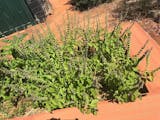The perennial staghorn plantain is an evergreen and hardy wild salad herb. The leaves contain a lot of calcium, vitamin A, vitamin B2 and vitamin C. A tasty mushroom-like and spicy-nutty salad addition. Ideal for direct sowing, pot cultivation possible, sowing spring-autumn, good for mixed culture, harvesting the leaves and flower buds.
Description
The staghorn plantain is a very old, perennial wild salad herb and grows wild in Central Europe on salt marshes and near the coast. The robust, hardy and evergreen wild plant forms elongated, toothed leaves in the shape of a staghorn antler and forms a rosette of leaves close to the ground. The leaves of the staghorn plantain contain a lot of calcium, vitamin A, vitamin B2 and vitamin C. The taste of the leaves is fresh, salty and spicy-nutty. The leaves and the young flower heads are edible and a tasty mushroom-like addition to pan-fried dishes.
General information
Plant family: Plantaginaceae
Life cycle: Perennial
Days to harvest: 100 days
Plant height approx.: 25 cm
Root type: Deep rooter
Nutrient requirements: Low
Water requirements: Low
Winter hardiness: Up to -23°C
Location: Sunny
Soil: Permeable, sandy, loamy, humus
pH value: 6 to 7
Sowing and planting information
Germination type: Light germinator
Sowing depth: 0 cm
Optimal germination temperature: 15-22 °C
Germination time: 3-14 days
Plant and row spacing: 25x25 cm
Germination ability of seeds: 30 years
Mixed culture
Optimal mixed culture: -
Unfavorable mixed culture: -
Sowing by climate zone
Subtropic climate (Mediterranean) (e. g. B. Portugal, Spain, Italy)
Direct sowing from January to December is recommended. The plants should ideally be planted in a sunny location.
Moderate climate (e. g. B. Germany, Switzerland, Poland)
Direct sowing from April to August is recommended. The ideal location for the plants is warm and sunny.
General recommendations
Direct sowing in rows is recommended. After germination, thin out the plants to the specified plant spacing.
Staghorn plantain ideally prefers a soil that is rather dry, low in nutrients, permeable, and contains sand, clay and humus. It does not tolerate waterlogging.
Additional tips
Staghorn plantain is resistant to drought and also thrives on sandy or stony, dry, saline soils. In order to quickly obtain a fine, crumbly and permeable soil with good nutrient and water storage capacity, additional incorporation of biochar and primary rock flour is recommended.
Type of propagation
Propagation occurs via seeds or root division.
Plant care
No care or fertilization necessary.
Other names
Botanical names: Plantago coronopus
English names: Bucks horn plantain, Staghorn plantain, Deer horn plantain
German names: Hirschhornwegerich, Krähenfuß-Wegerich, Kapuzinerbart, Minutina, Ziegenbart, Mönchsbart
Portuguese names: Minutina, Diabelha, Plantago
Spanish names: Llantén cuerno de ciervo
French names: Plantain vinaigrette
Origin
Country: Portugal



![Staghorn Plantain [Plantago coronopus]](http://www.benjis.net/cdn/shop/files/Hirschhornwegerich-Staghornplantain-Minutina-Plantagocoronopus-www.benjis.net.jpg?v=1710087649&width=1445)





